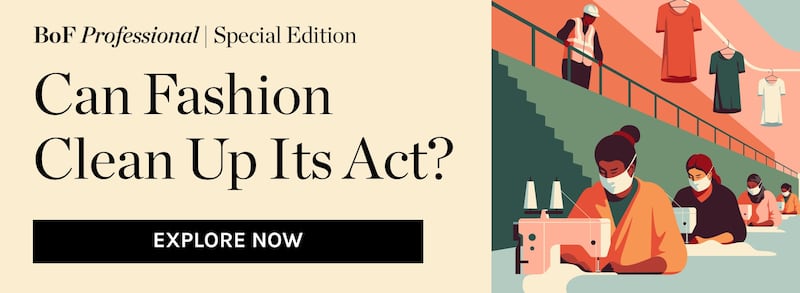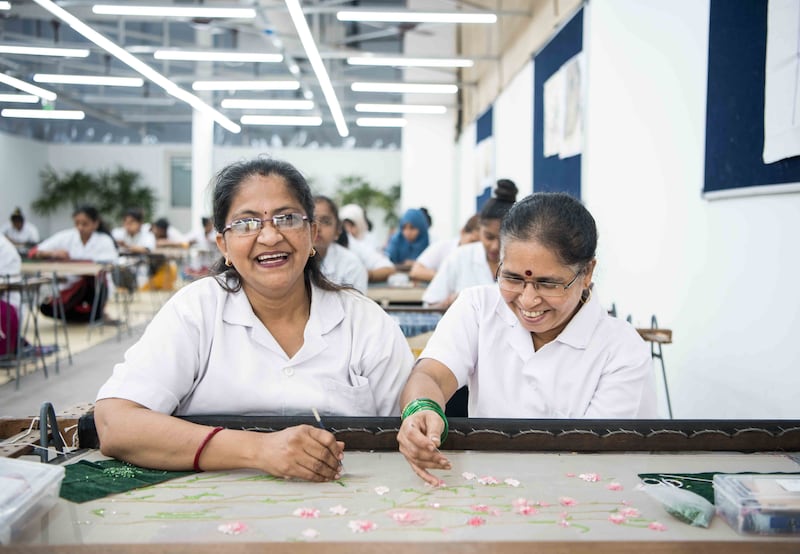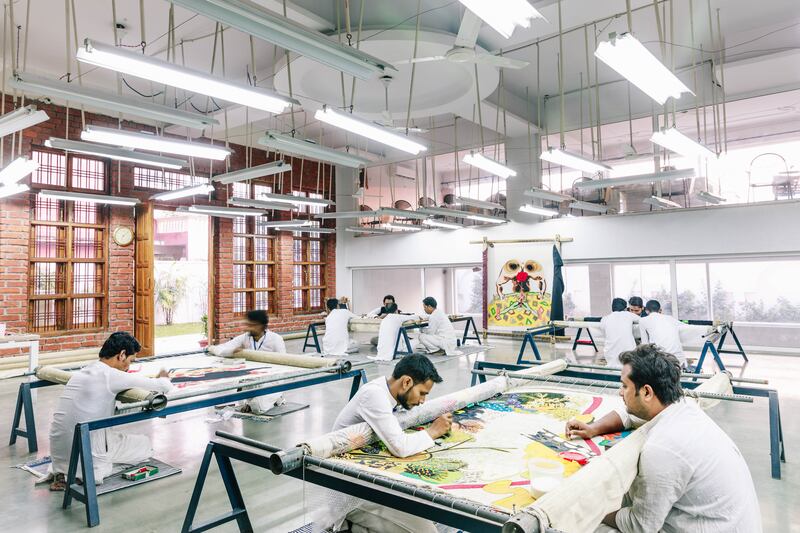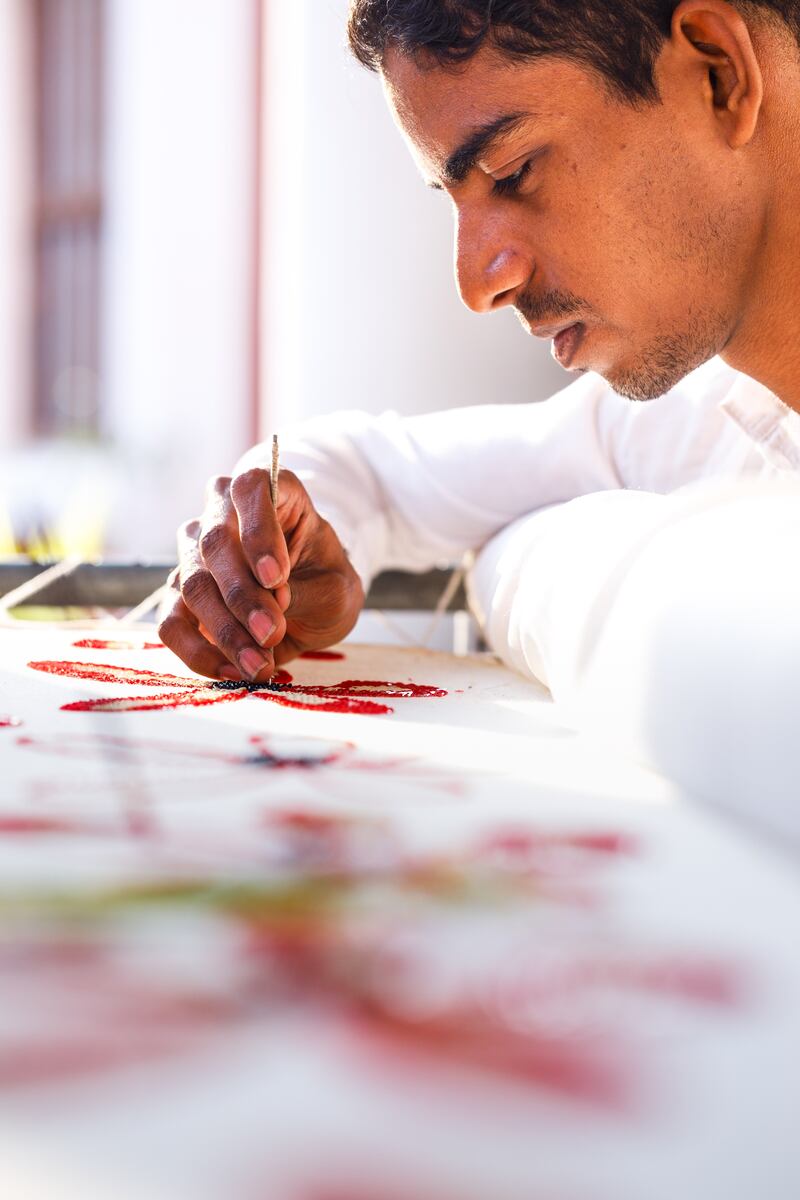
The Business of Fashion
Agenda-setting intelligence, analysis and advice for the global fashion community.

Agenda-setting intelligence, analysis and advice for the global fashion community.


This article is part of BoF’s special edition, Can Fashion Clean Up Its Act? Click here to learn more.
DELHI, India — "If my son becomes an artisan like me he won't have the money or the respect that he would have even if he were just a mechanic," says Rajab Khan, a master artisan from Uttar Pradesh, a state in northern India that flanks the nation's capital. Each month he sends money home to his elderly parents, wife, and his children aged between nine and fifteen.
For over twenty years Khan has been embroidering some of the most exquisite pieces that grace the catwalks and boutiques of global luxury brands. It has taken a lifetime to hone his superior craft, but all the precious skills he acquired could simply vanish, instead of being passed on to the next generation.
“I don’t know if I want my son to be an artisan like me. I never had the chance to study properly. I want him to speak English and get a good education,” he adds.
ADVERTISEMENT
While millions of factory workers across India toil for companies hired by international fast-fashion brands, there are also couture-level artisans like Khan, who are essential to European luxury brands that employ them indirectly through local export ateliers.
It is telling that in India, even while craft is venerated as a symbol of national pride, Indian artisans remain socially marginalised and poorly paid.
“Many young people don’t want to follow in their parents’ footsteps, seeing craft as having less status and social mobility than…an Uber driver. Why would so many skilled workers want to leave unless there was an inherent lack of recognition and respect for their work?" asks Ritu Sethi, chairperson at the Craft Revival Trust, a not-for-profit NGO established in 1999.
Undervaluing artisans is a problem not limited to India, but it is endemic in the country because of its hereditary caste system, reinforced by the pernicious marginalisation of its large Muslim minority – many of whom work in the apparel and textiles industry.
Karishma Swali, managing director of family-run company Chanakya, which produces for brands including Christian Dior, Gucci and Valentino, reminds us why artisans at her Mumbai-based export house are working for western brands in the first place. "Europe has high degrees of creativity, but these days fewer and fewer possess craftsmanship knowledge," she says.
Europe has high degrees of creativity, but these days fewer and fewer possess craftsmanship knowledge.
Of course, the fact that labour costs in India are so much lower than those in Europe also helps keep luxury brands motivated to produce here. It is estimated that luxury embroidery done in India would cost 10-15 times more to produce in Europe. Given their increasing reliance upon India for surface ornamentation like embroidery and other embellishments, it would make good business sense for brands to safeguard this essential industry so that it will continue to attract new generations of artisans.

The Chanakya School of Embroidery | Source: Courtesy
"There are three motivating factors [for luxury brands]," says Ashok Som, Professor and Global Strategy Director of the EMILUX programme at France's ESSEC Business School. "Diversifying their supply chain, global sustainability issues haunting the luxury brands vis-à-vis high ethical considerations that the brands [aim to] represent, and a shortage of highly-skilled craftsmen globally."
ADVERTISEMENT
Whatever their motivations – enlightened self-interest, pressure from consumers and shareholders or an emotionless cost-benefit analysis – luxury industry leaders have endeavoured to make some progress supporting artisans in India. Whether their initiatives are sufficiently fair and effective, however, is another matter.
Trial and Error
Although luxury brands have been using artisans' highly prized skills for years, until recently Indian artisans have been completely airbrushed out of the supply chain. But following a January exposé by BoF, The New York Times laid bare more of the problems inherent to this secretive industry in a March investigative report.
The latter exposed a secretive pact called Utthan (Sanskrit for "upliftment"), with founding members including Kering and LVMH. The pact, launched in 2016, set out to formalise embroidery workers' employment terms by implementing a standard minimum wage, health and safety measures, maximum working hours as well as mandatory provident fund and Employee’s State Insurance (ESIC) contributions.
Signatory brands committed to only work with Utthan-compliant factories by the second year, and several Indian export atelier firms in Mumbai who serve as suppliers and production managers for luxury brands also joined. UK-based consultancy Impactt was brought in to implement and monitor the measures suggested.
However, according to the report, implementation of the pact over the three years of its initial phase was piecemeal, with insufficient resources and oversight to ensure its success. Brands paid nothing towards the cost of implementing factory renovations for the health-and-safety measures suggested by the pact. Instead, suppliers spent their own money with no guarantee of future business. The report concluded that sub-contracting, low wages, poor working conditions and even crackdowns on collective worker organisation remained endemic.
In response to BoF’s requests for comment, both Kering and LVMH acknowledged problems with implementation of the pact and emphasised their ongoing commitment to resolving them. A Kering spokesperson also reiterated the company's earlier commitments to Indian artisans and its plan to open its own embroidery workshop in India, emphasising however that this is a long-term plan.
I know many embroiderers working for other factories who have not been paid. Many have returned to their villages. Who knows when they'll be able to return.
The group’s statement reads in part: “The goal is not to cover 100 percent of Kering brands’ hand embroidery works, but rather to get a direct and concrete knowledge of hand embroidery – from both a business and a technical perspective – and thus, also be able to better collaborate with external suppliers as regards working conditions, wages, prices and contractual commitments.”
ADVERTISEMENT
LVMH responded by offering a statement which clarified its intentions and conceded there is room for improvement. “For more than two years, LVMH has been committed with determination to constantly support the embroidery craftsmen based in Mumbai so that they benefit from better working and living conditions as well as a better recognition of their excellent craftsmanship. This is the meaning of our investment in the Utthan project,” the statement read, in part. “We still have a lot to do collectively, which is why we will significantly strengthen our participation in this project in order to accelerate these changes.”
The group contends that it is currently exploring several options in a bid to make good on its commitment to Indian artisans by tightening and strengthening control over its supply chain, such as creating its own workshop or taking a stake in one of its suppliers.
LVMH also explained its stance in relation to the COVID-19 outbreak in India. “We are currently working with all Utthan members to financially support the embroiderers by maintaining a remuneration while the activity starts again.”
In this regard, it appears that some highly-skilled artisans are in a better position than their less skilled compatriots – millions of whom are now facing destitution after work dried up or they were forced to flee back to their hometowns in a mass exodus after the lockdown was announced with only four hours warning on March 23 by India’s Prime Minister Narendra Modi.
Nevertheless, even for those who are comparatively lucky, the current crisis has been painful. “Things have been very hard; everyone is very, very scared,” says luxury embroiderer Rajab Khan, who out of concern for job security asked not to disclose which export atelier or brands he works for.
“It was too far to reach home [his village is 1,500 km away]. When the lockdown happened we thought it would just be for two weeks, so I decided to stay in Mumbai. We were given salary in advance for April, but I know many embroiderers working for other factories who have not been paid. Many have returned to their villages. Who knows when they’ll be able to return.”
“I talk to my family on WhatsApp every day. My children cry and miss me and tell me you must wear a mask and to be careful. I stay in a small place with other embroiderers here in Mumbai. We were shut inside with not much to do but wait and worry. We passed the time with much disturbance in our minds. We prayed together,” he adds.
Khan finally returned to work in the first week of May. “There is a lot of fear but we are happy to be working again. There are less people there now and we’re all worried about what will happen; we hope there will be enough work for us this year.”
The longer-term future for artisans like Khan remains highly uncertain. Given the decline in sales expected to hit the luxury industry this year, it is highly unlikely that brands will be commissioning Indian suppliers to produce as many intricately embroidered pieces as they usually do. For unfortunate artisans who are selected to be laid off, the consequences can be dire.
Putting the current crisis to one side, recent steps made by the luxury industry to improve the welfare of its artisans are of course welcome. But the earlier failures of Utthan and the deeply embedded structural inequality of Indian society demonstrate that making progress will not be easy. What’s more, luxury brands must keep in mind that there are a number of other complex issues to navigate if they want to clean up their supply chains.
Misleading Provenance
Given loopholes in country of origin laws, European brands are able to indicate “Made in France” or “Made in Italy” provenance for fashion items which in reality have only been finished in Europe.
As Sethi says, “there is a crucial difference between protecting information regarding supplier sources or lying about provenance.”
Being transparent about where items were embellished, perhaps even creating a special mark to designate embroidery done in India, would begin to create awareness among international luxury consumers and lead to the increased recognition and respect that Indian artisans deserve.
Som from ESSEC warns that aligning business motivations with social consciousness is not always straightforward. “The conditions have to be linked with the storytelling part of the brand and has to be integral to the brand DNA. The real question is whether the French and Italian luxury brands are ready yet to promote the work of [artisans from outside Europe in sourcing countries like India],” he explains.
There is a crucial difference between protecting information regarding supplier sources or lying about provenance.
Some are willing to be more transparent than others. Since 2007, Hermès has put a “Made in India” label on its range of “Les Exceptionnelles” embroidered silk scarves and plaid cashmere throws. Having found the fit between Indian craft excellence and its own DNA, the luxury brand now releases new “Made in India” pieces each season.
At Kering, the group’s March press release included its first public acknowledgment of the role of India’s artisans: “Most of the luxury brands in the world rely on Indian know-how for hand embroidery,” it read.
Even light-touch moves to celebrate the partial Indian heritage of European luxury brand products are welcome. In collaboration with Maria Grazia Chiuri and Dior, Chanakya started an embroidery school for women and, although it is regarded by most as a CSR initiative, the fact that banners embellished by women embroiderers were featured in the latest Dior show during Paris couture week is a step in the right direction for an industry that needs to be more honest about its relationship with artisans from India and other countries in the developing world.
It is worth noting that compared to fast fashion, luxury brands are generally still remarkably opaque. According to Fashion Revolution's 2020 Fashion Transparency Index, which ranks brands out of a 100 percent possible score, "high street brands lead on transparency but luxury brands are making progress." Indeed, the top scores were for H&M (73 percent) and C&A (70 percent), followed by sportswear brands Adidas and Reebok. While affordable luxury players like Calvin Klein and Tommy Hilfiger did make it into the 51-60 percent range, pure luxury brands all scored 48 percent, or lower.
Making further progress in terms of transparency is important because it is inextricably linked to fair pay. Transparency provides the practical groundwork and builds the cultural value necessary to recognise Indian artisans as valued agents in supply chains. As it currently stands, lack of transparency means many brands are able to exploit the structural inequalities inherent in Indian craft while passing their work off as European.
Unfair Status
The structural inequality of Indian society first impacts artisans at the very start of their careers, long before they make the trip to big cities in search of a better life. Artisans typically enter the industry through the guru-shishya parampara (Hindi for the teacher-pupil tradition of succession) in rural villages where they learn embroidery in a small workshop of five or six people. The most talented move on to bigger workshops in nearby towns until the best among them are eventually recruited by the export ateliers in hubs like Mumbai.
But because these artisans have had no formal education, they are relegated to the position of daily wage labourer, even though they possess exceptional skills essential to the luxury supply chain. In fact, insiders say their skills are often on par with or better than their counterparts in Europe who are paid at least ten times more.

Students at The Kalhath Institute | Source: Courtesy
“It’s my 23rd year in this business and I’m learning new things every time I spend time with the artisans. There can be seven-hundred variations on a stitch. Their skill is the foundation [of it all],” says Swali of Chanakya. The founders of other Indian export houses like Milaaya and Aditiany similarly praise the level of their artisans’ work.
But for artisans to gain similar recognition to their counterparts in Europe, they need more formal structures for education, qualification schemes and ongoing skills development throughout their working life. Recognition is the first step toward being more highly valued, which is key to be able to command better pay and working conditions.
To this end Max Modesti, the founder and director of Les Ateliers 2M, a specialist luxury embroidery and textile company in Mumbai, founded the Kalhath School of Embroidery in 2016 in Lucknow, Northern India, an area renowned for exquisitely intricate chikankari embroidery.
“Craft value can be created only through education — empowering women and men artisans is essential,” says Modesti, explaining that the purpose of the institute is to give a professional education to artisans who never had the chance to pursue studies.
“We felt it was essential to create this one-year intensive education course, as craft businesses like embroidery lack middle management able to coordinate teams of workers, understand design and marketing, and maybe raise up entrepreneurs,” he adds.
With the training of new leadership roles comes an opportunity for some artisans to move up the ladder and be able to pursue new options in a richer career path. For now, the number of students is small, but the Kalhath Institute’s approach to career development seems to be a model for brands to learn from.
Race to the Bottom
One way Utthan reinforced broader structural inequality is in its interpretation of what constitutes a living wage for a highly-skilled artisan. It followed what exporters typically pay embroiderers based on the state of Maharashtra’s (which includes Mumbai) category of skilled workers. There is no official government designation for a skilled high-end embroiderer, instead they are clubbed together in a broadly defined skilled labour category.
Hence Utthan set the monthly wage at 16,000 rupees ($209), a low wage considering the cost of living and relatively high rents in Mumbai. But because this amount also includes insurance contributions and two hours mandated overtime, Utthan embroiderers end up taking home just 13,000 ($170) or less. As a result, some have argued that they are even worse off since they can no longer officially supplement wages through extra overtime. Secretly though, some artisans still do overtime way above the legal limits as they are desperate to earn more.
Recognition and respect are the cornerstones of transforming the conditions for the artisans.
Given the enormous margins made by luxury brands, campaigners assert that there is room to increase artisans' pay to allow them a better standard of living, where they are not compelled to work sixteen-hour days in order to earn enough to support their families back home. Yet what the local export ateliers who manage artisans consistently report is that luxury brand representatives continue to push down prices, making it difficult to raise artisans’ wages.
Modesti rejected the invitation to join Utthan, believing it sought to burnish the reputation of luxury conglomerates without any real commitment to the artisans. He says he pays artisans 50 percent more than the amount stipulated by Utthan, claiming that it is possible in part because his clients guarantee regular work regardless of seasonal swings or trends, and pay consistently and fairly for production costs.
"I've got these stable clients, and we've signed a production agreement and it's clear," explains Modesti, referring to his company's long-standing partnership with the brands for whom it produces embroideries, namely Hermès, Chanel and Isabel Marant.

The Kalhath Institute | Source: Courtesy
“Today we are in a completely different position from all these manufacturers around us, because basically we don’t need to fight with prices, we don’t need to fight with orders, we don’t need to go and steal the client of another one by trying to make the same piece cheaper. This happens in the other luxury brands today as we speak,” he claims.
Aggressively pushing supplier prices down is a sourcing practice associated more with fast fashion than luxury brands, given the latter’s prestige positioning and high profit margins. But according to Modesti (and other export atelier owners BoF spoke to under the condition of confidentiality for this article), only a few of the luxury brands who source embroideries and surface embellishments from the many specialist export ateliers in Mumbai adhere to more ethical business practices.
Yet all luxury brands – not just a handful – have the potential to make a real difference to artisans’ lives. One subtle but important way for brands to move in the right direction is to fundamentally rethink the status of international artisans in the corporate organisation.
Luxury’s ‘Respect Deficit’
As Sethi says, “recognition and respect are the cornerstones of transforming the conditions for the artisans.” But she adds that while it may seem inconsequential at first glance, paying due respect to artisans in their day-to-day working life is not something that happens everywhere. In fact, many luxury brands still have a “respect deficit.”
One export atelier where respect does appear to be a guiding principle, however, is the embroidery firm Vastrakala which was set up by Jean-François Lesage and business partners Patrick Savouret, Malavika Shivakumar and Sandeep Rao in Chennai, southern India. Vastrakala’s parent company Lesage, is itself now part of Chanel's Paraffection subsidiary, the French luxury giant’s stable of couture artisan workshops.
“[Our] company is dedicated to work of excellence, and to make artisans the most important people within the structure,” explains Lesage.
It is instructive to observe Lesage and the artisans at Vastrakala. As Indian embroiderers, dressed in a uniform of white coats denoting their status as master artisans, work on various embroideries, Lesage converses with them, bringing over books to discuss a particular technique or encouraging them to stop and look at each other’s work while sharing opinions on how something could work better or differently.
It seems that intangible forms of respect are the foundation for more tangible forms of respect, like offering fairer pay and healthcare insurance, something associated with the company’s status of SA8000 certification (a global social certification standard for factories and organisations established in 1997 by Social Accountability International).
But for Modesti, in order to fairly treat and compensate artisans, the luxury industry needs a more sustainable future in India and that means cleaning up its supply chain. The only way to do that, he says, is to own it – literally.
“What I foresee in the next 20 years is luxury groups slowly, slowly acquiring Indian excellence [and] craftsmanship. They will have to integrate it. Because that will be the only way for them to be truly ethical and sustainable,” he asserts.
“There won’t be any other way.”
Disclosure: LVMH is part of a group of investors who, together, hold a minority interest in The Business of Fashion. All investors have signed shareholder’s documentation guaranteeing BoF’s complete editorial independence.

BoF Professional Special Edition: Can Fashion Clean Up Its Act?
As the world grapples with an unprecedented public health and economic crisis, exposing deep-rooted social inequality as a climate emergency looms, the fashion industry must learn to respect both people and the planet. It's time for fashion to build a more responsible business model. Explore the full special edition here.
1. Can Fashion Clean Up Its Act?
2. Will Fashion Ever Be Good for the World? Its Future May Depend on It
3. How to Avoid the Greenwashing Trap
4. Luxury Brands Have a 'Respect Deficit' with Indian Artisans
5. Investing in the Sustainability Sisterhood
6. Why Luxury Came to the Rescue
7. The BoF Podcast | Jochen Zeitz on the Power of Fashion to Drive Sustainable Change
and more.
The BoF Professional Summit: How To Build a Responsible Fashion Business
On June 17 2020, we will gather leading global experts, entrepreneurs and activists in sustainability, ethical supply chains and workers' rights for a half-day programme of interactive conversations, panel discussions and workshops on building a responsible business, led by BoF's expert editors and correspondents. Space is limited. Register now to reserve your spot.
This week’s round-up of global markets fashion business news also features the China Duty Free Group, Uniqlo’s Japanese owner and a pan-African e-commerce platform in Côte d’Ivoire.
Affluent members of the Indian diaspora are underserved by fashion retailers, but dedicated e-commerce sites are not a silver bullet for Indian designers aiming to reach them.
This week’s round-up of global markets fashion business news also features Brazil’s JHSF, the Abu Dhabi Investment Authority and the impact of Taiwan’s earthquake on textile supply chains.
This week’s round-up of global markets fashion business news also features Dubai’s Majid Al Futtaim, a Polish fashion giant‘s Russia controversy and the bombing of a Malaysian retailer over blasphemous socks.